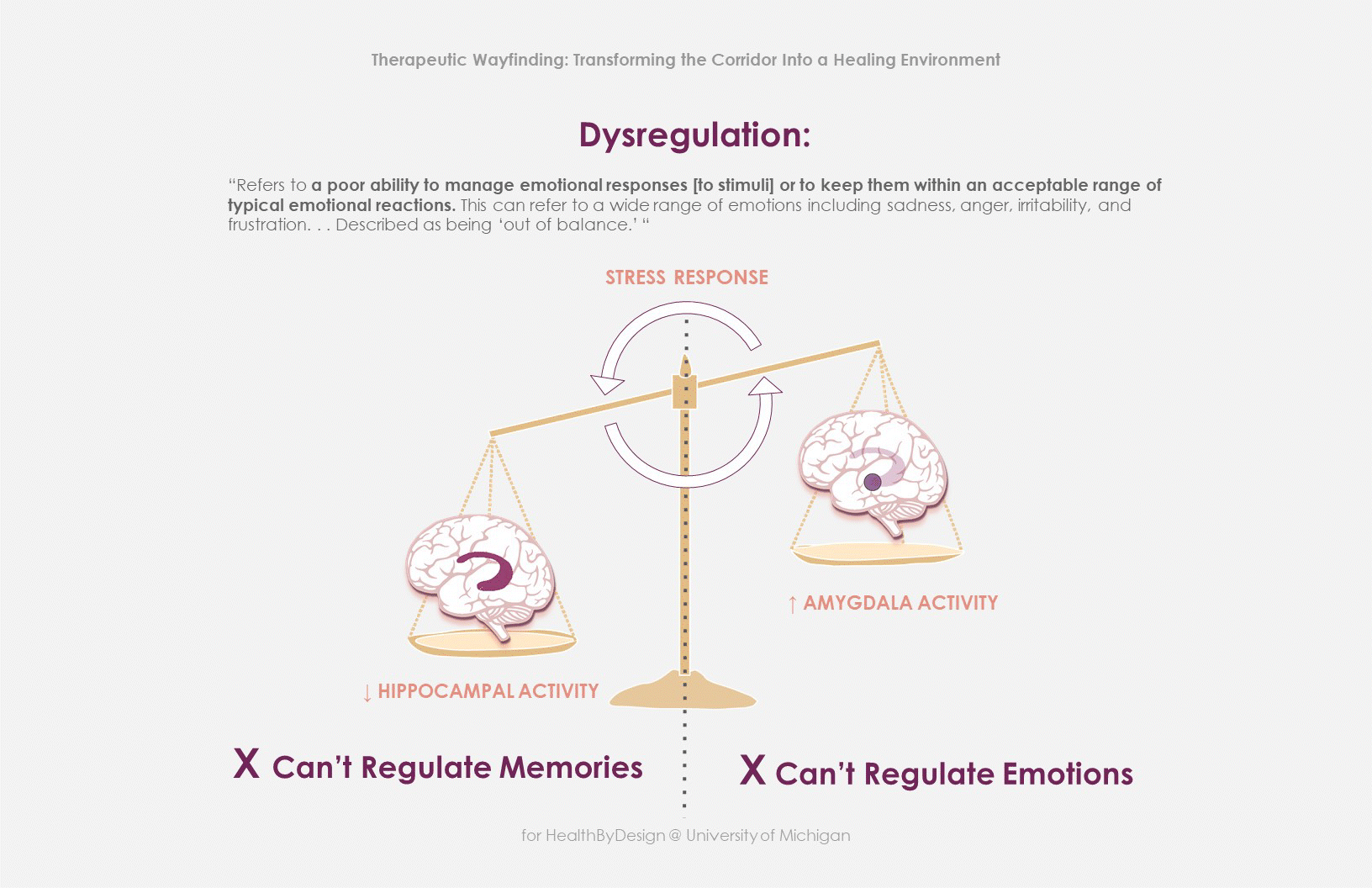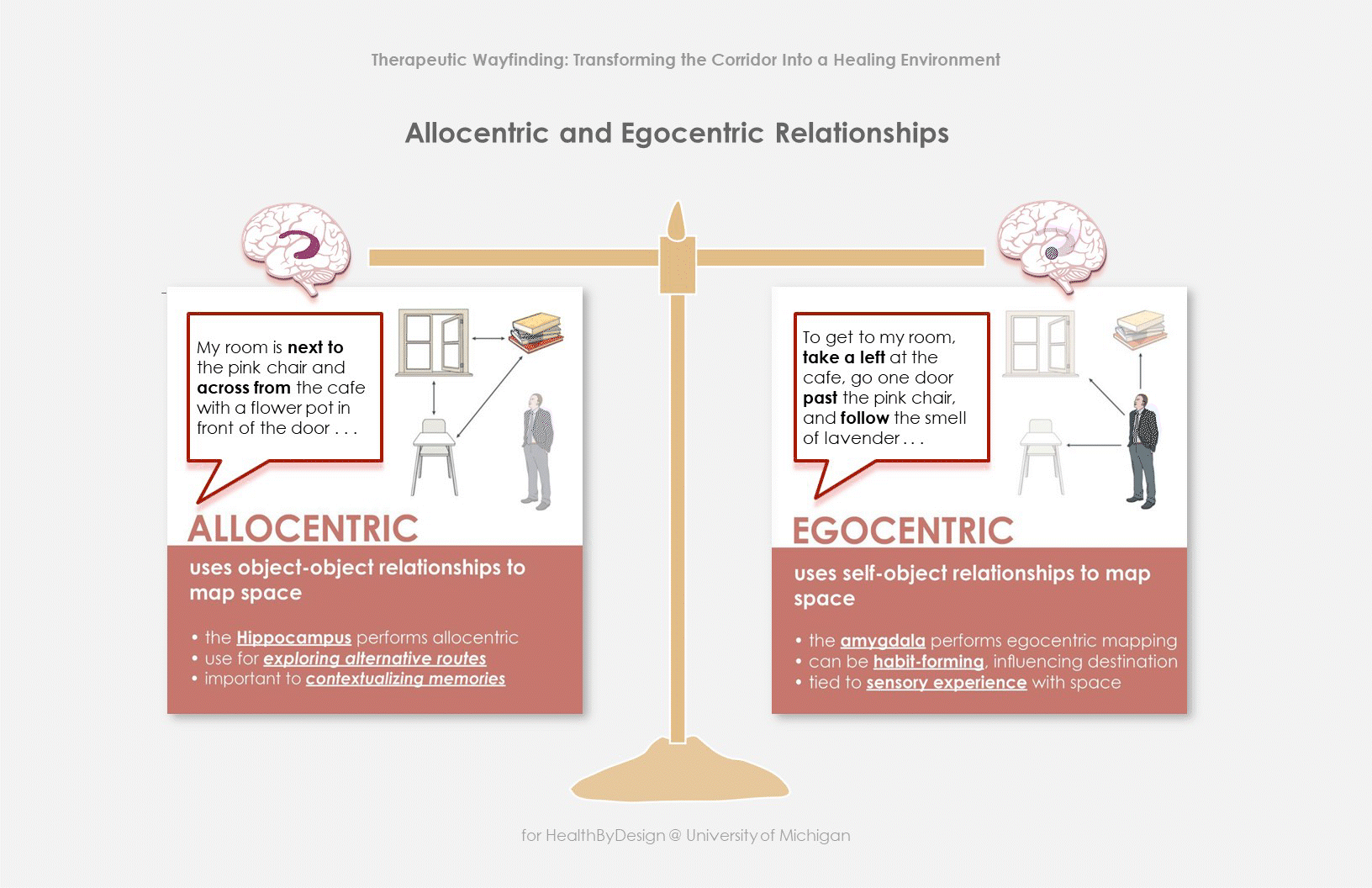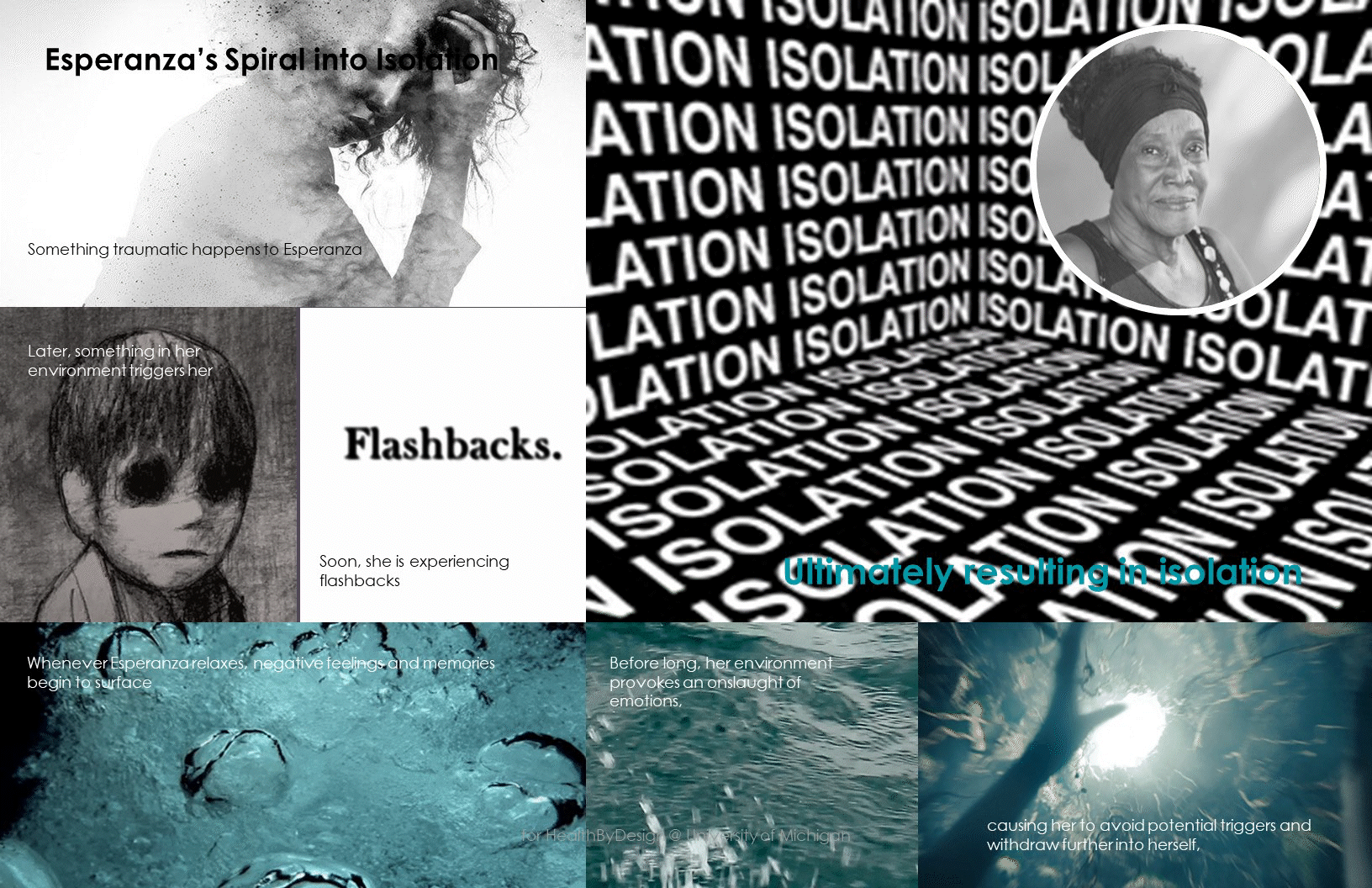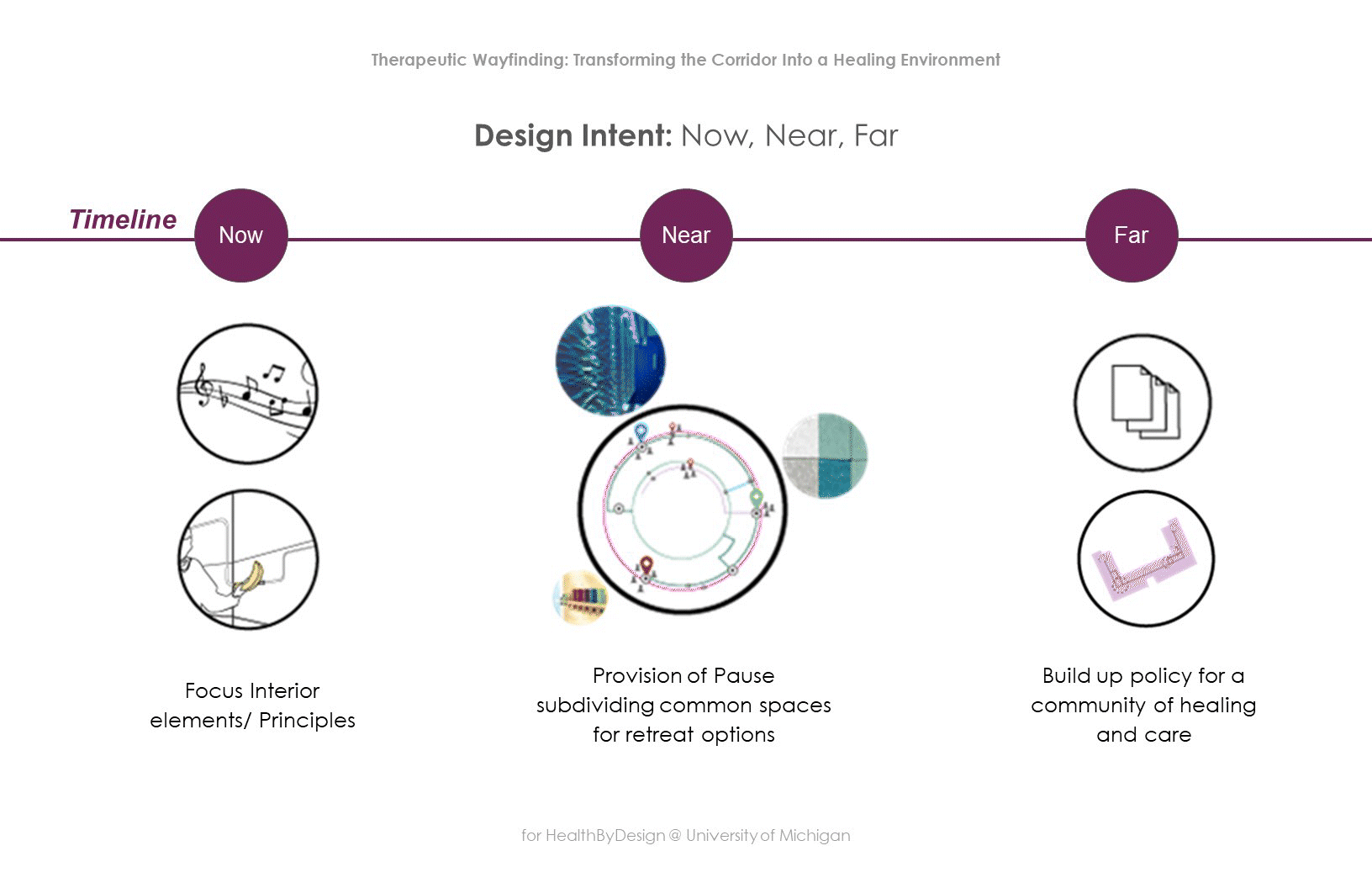︎
Therapeutic Wayfinding: Transforming the Corridor Into a Healing Environment
How can the corridor be transformed from a space of disorientation into a stabilizing and re-regulating place that enriches the broader therapeutic environments and supports healthy aging?
By Aidan Barron ︎ , Chun-Li Chen (Julie) ︎ , Elyssa Bakker ︎ , Irene Routte ︎

Why
Studies show that some of the first tasks affected by cognitive loss are those that involve spatial learning and spatial memories. (O’Malley, 2018). It has also been demonstrated that those who have experienced complex trauma or PTSD also suffer cognitive impediments that impact spatial navigation (Smith, 2015). In particular trauma impacts the brain’s ability to process both memories and emotions due to changes that occur to both the hippocampus and amygdala (Fidalgo, 2016). Changes in the amygdala of someone with PTSD causes increased response to stimuli which causes a person to experience dysregulation. Dysregulation, a hallmark of trauma/PTSD, arises from an exaggerated response to a threat and/or inability to regulate negative emotional states. In addition, hippocampal changes in the brain limits the ability for contextualizing memories. This contributes to a lowered capacity for allocentric processing because of the lack of memory for object location relative to spatial boundaries (Fidalgo).To compensate for this lack, egocentric processing, or navigating spatially based on self-to-object, is relied on more heavily for wayfinding (Allocentric vs. Egocentric Spatial Processing, 2021).


Dysregulation/ Graphic by Elyssa Bakker
Allocentric vs Egocentric / Graphic by Elyssa Bakker
Net Effect of Allocentric and Egocentric Imbalance / Graphic by Elyssa Bakker
Reliance on egocentric processing increases trauma survivor’s need to rely on sensory cues for wayfinding which then heightens the chances for dysregulation. Experiencing a trigger, due to intrusive cognitive or somatic memory may cause dissociation, flashbacks, and physiological responses. These intrusive memories occur from an inability to ground oneself due to detached sensory stimuli causing disconnection from the present moment and place. Transitional spaces, for instance corridors are particularly triggering due to unfiltered stimuli, lack of identity markers and absence of places or tools for re-regulation. Reregulation and grounding techniques often use sensory cues, sound, touch, sight to connect an individual to the here and now, reassure them of safety and/or detach from emotional pain (Ottoboni, 2013). Therefore, we question how corridors, where dysregulation may occur, can be transformed into a space that provides in its design ways for continuous re-regulation and supports therapeutic wayfinding. Trigger-inducing experiences within the corridor can be inhibitors to autonomous exploration and community participation, and both activities are essential to healthy-aging. By removing stressors from the corridors, as well as building well-designed grounding elements and navigational cues, this project intends to facilitate therapeutic wayfinding and increased autonomy within vulnerable residential communities.
The Corridor: Unfiltered Anxiety Inducing / Graphic by Elyssa Bakker, Chun-Li Chen


Personas and their inaccessible loop / Graphic by Chun-Li Chen, Elyssa Bakker; Persona created by Irene Routte
Personas and their inaccessible loop / Graphic by Aidan Barron
We are designing for those who have experienced trauma because when we design for those who are most vulnerable around us, we design for everyone. While Universal Design is geared towards the design of environments that are usable by all people, it does not take into account the specific ways that spatial navigation differs for those who are experiencing PTSD and symptoms of trauma (The Center for Universal Design, 2021). Furthermore, according to the Substance Abuse and Mental Services Administration, 61% of men and 51% of women in the United States have been exposed to at least one traumatic event in their lifetimes (Van den Berk-Clark, 2017). If we neglect the experience of such a great number of our community members, we are not designing with a perspective of better health for all.
Hypothesis / Hypotheses
- If we improve allocentric cues through placemaking and distinct audiovisual landmarks, we can facilitate wayfinding and re-regulation for trauma exposed and aging adults.
- If we embed identity anchors, such as personalized features and interactive tactile activities along the corridor, egocentric navigation can be improved, route-learning can be reinforced, and re-regulation can be better supported for trauma-exposed adults.
Who are we designing for and the relationship with design continuum / Graphic by Chun-Li Chen (Julie), Elyssa Bakker ; Concept Develop by Aidan Barron, Chun-Li Chen, Elyssa Bakker, Irene Routte
We are focused on designing interventions for seniors living in Federally subsidized, low income independent living at Woodbridge Village in Detroit. Elders living there are 62 years and older and are majority African American. We are particularly designing for those who may be the most vulnerable within this space. Those who have experienced multiple instances of trauma, and may have not had access to care at younger ages due to lack of resources or stigma. Examples of personas that we are designing for include elders who have experienced complex trauma, Intimate Partner Violence (IPV), chronic houselessness, witnessing community violence, experience of historical trauma and PTSD from service in the military.
Research Path / Graphic by Chun-Li Chen (Julie), Elyssa Bakker;
Concept
Develop
by Aidan Barron, Chun-Li Chen, Elyssa Bakker,
Irene Routte
How
This design challenge was first formulated through field observation at Woodbridge Village. After this occurred we conducted a thorough literature review of cognitive changes, spatial navigation and trauma. We looked at both peer reviewed sources, as well as sources from current practitioners in the design field. Based on several previous case histories, we created two personas with differing trauma histories and differing symptoms (dysregulation and dissociation) who we aimed to design for. In addition we consulted with two professors of Social Work who specialize in trauma informed interventions as well as trauma and cognition.

Design Intervention/ Graphic by Chun-Li Chen, Elyssa Bakker; Concept Develop by Aidan Barron, Chun-Li Chen, Elyssa Bakker, Irene Routte
What
Trauma informed design principles speculate that grounding elements such as identity anchors--achieved through personalization of space and somatic interactions--and contextual maps--achieved through distinct landmarks--can provide the needed opportunities for re-regulation along corridors. We will improve allocentric navigational performance which will provide opportunities for both re-regulation and reduction of intrusive memories. This will also impact the ability for those relying heavily on egocentric wayfinding. Designing corridors that provide context cues as well as places to continuously reregulate will improve willingness of residents to leave room and explore and create a greater sense of residential autonomy. These elements can also be leveraged to improve wayfinding for the benefit of not only trauma-exposed individuals, but the broader population by enhancing allocentric and egocentric cues for route learning ensures safety, choice, and empowerment.
Design Outcomes/ Graphic by Chun-Li Chen, Elyssa Bakker; Concept Develop by Aidan Barron, Chun-Li Chen, Elyssa Bakker, Irene Routte
Design To Outcomes
Designing contextual relationships and distinct landmarks within the built environment
- Attends to hippocampal changes by increasing individuals allocentric wayfinding abilities
- Attends to amygdala changes by providing spaces and places for re-regulation along corridors.
So What
Using trauma-informed design interventions ensure that all residents, especially those who are most marginalized, have the confidence and comfort to move through in their living space. Confidence in mobility increases autonomy which affects both social interaction as well as the potential of further cognitive decline. Increasing wayfinding abilities for a longer period of time allows for less caregiver support, as well as promotes autonomy, which is a factor in preventing further cognitive decline. By focusing on trauma informed wayfinding for the most vulnerable; elderly, minoritized communities, those with mental, developmental and physical disabilities, we in fact design more accessible and equitable environments for all.
︎︎︎Link To Project Research Miro Board
︎︎︎Link To Project The Design Continuum Paper
︎
Works Cited
1. Cicago style Citation“Allocentric vs. Egocentric Spatial Processing.” Imagery Lab RSS. Accessed December 8, 2021. https://www.nmr.mgh.harvard.edu/mkozhevnlab/?page_id=308.
2. Caballar, R. D. (2021, October 7). Neuroaesthetics: Mental Health Facilities of the Future. NEO.LIFE. Retrieved October 13, 2021, from https://neo.life/2021/10/neuroaesthetics-mental-health-facilities-of-the-future/.
3. Clay, J. (2019, April 19). For Alzheimer's and Dementia Patients, Thoughtful Design Can Have Big Impact. USC School of Architecture. Retrieved October 12, 2021, from https://arch.usc.edu/news/for-alzheimers-and-dementia-patients-thoughtful-design-can-have-big-impact.
4. Doeller CF, King JA, Burgess N (2008) Parallel striatal and hippocampal systems for landmarks and boundaries in spatial memory. Proc Natl Acad Sci U S A 105:5915–5920, doi:10.1073/pnas.0801489105, pmid:18408152.
5. Fidalgo, C., Martin, C. The Hippocampus Contributes to Allocentric Spatial Memory through Coherent Scene Representations. Journal of Neuroscience 2, March 2016, 36 (9) 2555-25557; DOI: 10.1523/JNEUROSCI.4548-15.2016
6. Fitzgerald, J. M., DiGangi, J. A., & Phan, K. L. (2018). Functional Neuroanatomy of Emotion and Its Regulation in PTSD. Harvard review of psychiatry, 26(3), 116– 128. https://doi.org/10.1097/HRP.0000000000000185.
7. Jhirad, D. (2021, September 21). Trauma-informed design. Davis Brody Bond. Retrieved October 12, 2021, from https://www.davisbrodybond.com/events-dialogues2/dbb-aia-discover-architecture-2021-zt5dh.
8. Kuliga S, Berwig M, Roes M. Wayfinding in People with Alzheimer’s Disease: Perspective Taking and Architectural Cognition—A Vision Paper on Future Dementia Care Research Opportunities. Sustainability. 2021; 13(3):1084. https://doi.org/10.3390/su13031084
9. Marquardt, G. (2011). Wayfinding for People with Dementia: A Review of the Role of Architectural Design. HERD: Health Environments Research & Design Journal, 4(2), 75–90. https://doi.org/10.1177/193758671100400207
10. Mollerup P. (2016) The Challenge of Wayfinding in Health Care Environments. In: Hunter R., Anderson L., Belza B. (eds) Community Wayfinding: Pathways to Understanding. Springer, Cham. https://doi-org.proxy.lib.umich.edu/10.1007/978-3-319-31072-5_6
11. Ottoboni G. (2013). Grounding clinical and cognitive scientists in an interdisciplinary discussion. Frontiers in psychology, 4, 630. https://doi.org/10.3389/fpsyg.2013.00630
12. Smith, K., Burgess, C. Brewin, C. Impaired allocentric spatial processing in posttraumatic stress disorder,Neurobiology of Learning and Memory, Volume 119, 2015, Pages 69-76, https://doi.org/10.1016/j.nlm.2015.01.007.
13. “The Center for Universal Design.” Center for universal design NCSU - about the center - Ronald L. Mace. Accessed December, 2021. https://projects.ncsu.edu/ncsu/design/cud/about_us/usronmace.htm.
14. Wiener, J.M., Pazzaglia, F. Ageing- and dementia-friendly design: theory and evidence from cognitive psychology, neuropsychology and environmental psychology can contribute to design guidelines that minimise spatial disorientation. Cogn Process (2021). https://doi.org/10.1007/s10339-021-01031-8
15. van den Berk-Clark, C., & Patterson Silver Wolf, D. (2017). Mental Health Help Seeking Among Traumatized Individuals: A Systematic Review of Studies Assessing the Role of Substance Use and Abuse. Trauma, violence & abuse, 18(1), 106–116. https://doi.org/10.1177/1524838015596344